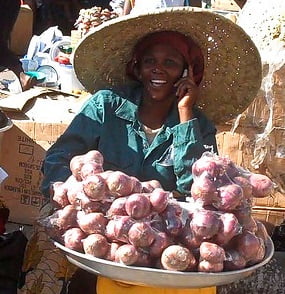Social Good Summit, New York – UN Dispatch was at the Social Good Summit in New York this week, drinking from the fire hose of knowledge as speaker after speaker talked about their exciting, innovative and bold efforts to make the world a better place. Here, we attempt to distill the essence of the lessons of the Social Good Summit. In Part 1, we analyze what are the strategies that drive many – if not most – of the initiatives discussed at SGS. In Part 2, UN Dispatcher Kim Curtis looks at the thematic foci of the SGS, and what issues social changemakers are honing in on today.
It’s All About Mobile Devices, Baby
One of the major concepts threaded throughout the conversations that took place at the Social Good Summit was the importance of mobile devices. Indeed, whether we are talking about malaria, ending violence against women and children, youth empowerment, climate change or organizational effectiveness, the mobile device is a key tool in all these initiatives. In less than a decade, cell phones and mobile devices have spread globally in a dramatic fashion – there are 7 billion mobile connections globally today, and we’re on track for 95% mobile connectiveness by the end of 2015. The humble cell phone will be a driver of economic, technological, social and political change. Mobile devices have a lot going for them: in addition to being almost universally available, they provide an avenue for the development of low-cost, high-impact tools. For example, a mobile app that allows business people in remote locations to access market information isn’t onerous to develop. Similarly, reporting tools – such as the Ushahidi platform or HarassMap – also take advantage of the cheapness and availability of mobile connections. Social and viral campaigns will increasingly use mobile tools to mobilize people and raise awareness, or to encourage behavior modification (e.g. 6 million MTN subscribers receiving free health PSAs via text message). The Social Good Summit speakers reinforced just how much mobile devices are transforming our world, and can be used in an endless variety of ways to improve livelihoods and work towards solving critical issues.
Cross-Sector Cooperation or Bust
Another key take-away from the Social Good Summit was the general emphasis on the need for cross-sector cooperation. Effective changemakers must collaborate – in our profoundly interconnected world, no longer can any one actor work alone. As discussed during several sessions on climate change and health, collaboration between governments – who can make and enforce policy and standards – and private companies – who can help fund programs, provide expertise and help scale successful work – are vital to ensure that initiatives succeed.
But beyond the need for public-private partnerships, the role of the individual – now empowered by his or her mobile device, as discussed above – is also critical to success. The UN Foundation’s Tim Wirth made this very clear during a session climate change, explaining that individuals have not only the responsibility but the ability to bring change to Washington. Community groups, non-profit organizations, and NGOs have traditionally fueled social, economic and political change, and in this brave new digital world, will continue to be a powerful force for positive change. These groups also benefit from partnering with governments and the private sector, increasing the potential impact of their actions through effective cross-sector collaboration.
The “sustainable” piece of sustainable development can only truly be realized when all sectors of society have a stake in it, participate actively and work together towards common goals. This still fairly new mode of deep cross-sector cooperation, enabled by a powerful range of digital and mobile tools, will define successful social change initiatives.
Photo credit: CarribeanFreePhoto
